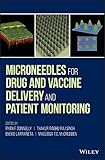Microneedles for drug and vaccine delivery and patient monitoring / edited by Ryan F. Donnelly, Thakur Raghu Raj Singh, Eneko Larrañeta, and Maelíosa T.C. McCrudden.
Material type: TextPublisher: [Place of publication not identified] : John Wiley and Sons, Inc. : Wiley, 2018Description: 1 online resourceContent type:
TextPublisher: [Place of publication not identified] : John Wiley and Sons, Inc. : Wiley, 2018Description: 1 online resourceContent type: - text
- computer
- online resource
- 9781119305163
- 1119305160
- 9781119305101
- 1119305101
- 615.6 23
- RM151
- WB 340
Includes bibliographical references and index.
Online resource; title from PDF title page (EBSCO, viewed June 11, 2018).
Cover; Title Page; Copyright; Contents; List of Contributors; About the Editors; Preface; Chapter 1 Genesis of Transdermal Drug Delivery; 1.1 Skin Anatomy; 1.1.1 The Epidermis; 1.1.2 The Stratum Corneum; 1.1.3 The Dermis; 1.1.4 Skin Appendages; 1.2 Routes to Percutaneous Drug Absorption; 1.3 Facilitated Transdermal Drug Delivery; 1.3.1 Electrical-based Devices; 1.3.1.1 Iontophoresis; 1.3.1.2 Electroporation; 1.3.1.3 Ultrasound; 1.3.1.4 Cryopneumatic and Photopneumatic Technologies; 1.3.1.5 Velocity-based Devices; 1.3.1.6 Thermal Approaches (Lasers and Radiofrequency Heating)
1.3.1.7 MicroneedlesReferences; Chapter 2 Microneedle Manufacturing and Testing; 2.1 Introduction; 2.2 Material Types, Properties and Biocompatibility; 2.2.1 Silicon; 2.2.1.1 Biocompatibility of Silicon; 2.2.2 Metals; 2.2.2.1 Biocompatibility of Metals; 2.2.3 Ceramics; 2.2.3.1 Biocompatibility of Ceramics; 2.2.4 Silica Glass; 2.2.4.1 Biocompatibility of Silica Glass; 2.2.5 Carbohydrates; 2.2.5.1 Biocompatibility of Carbohydrates; 2.2.6 Polymers; 2.2.6.1 Biocompatibility of Polymers; 2.3 Microneedles Manufacturing and Design; 2.3.1 Basics of Microfabrication; 2.3.1.1 Lithography and Etching
2.3.1.2 Thin-film Deposition on Substrates2.3.1.3 Etching; 2.3.2 Microfabrication MNs; 2.3.2.1 Fabrication of Silicon MNs; 2.3.2.2 Fabrication of Metal and Glass MNs; 2.3.2.3 Fabrication of Polymeric MNs; 2.3.3 Microneedle Design; 2.4 Microneedle Mechanical Characterisation; 2.4.1 Axial Force Microneedle Mechanical Tests; 2.4.2 Transverse Force and Shear Strength Microneedle Mechanical Tests; 2.4.3 Baseplate Strength and Flexibility Tests; 2.4.4 Microneedle Insertion Measurements; 2.4.4.1 Staining of Microneedle-treated Skin; 2.4.4.2 Transepidermal Water Loss Measurements
2.4.4.3 Electrical Impedance Measurements2.4.4.4 Histological Tissue Staining and Sectioning; 2.4.4.5 Confocal Microscopy; 2.4.4.6 Optical Coherence Tomography; 2.4.5 Significance of Microneedle Test Results; References; Chapter 3 Microneedle-mediated Drug Delivery; 3.1 Introduction; 3.2 Microneedle Drug Delivery Strategies; 3.2.1 Solid Microneedles; 3.2.2 Coated Microneedles; 3.2.3 Hollow Microneedles; 3.2.4 Dissolving Microneedles; 3.2.5 Hydrogel-forming Microneedles; 3.3 Conclusion; References; Chapter 4 Microneedle-mediated Vaccine Delivery; 4.1 Introduction; 4.2 Vaccine Delivery
4.2.1 Vaccination4.2.2 Alternative Vaccine Delivery Options; 4.3 Intradermal Vaccination; 4.3.1 Skin Structure; 4.3.2 Skin Immune Response; 4.3.3 Conventional Strategies for Intradermal Vaccine Delivery; 4.4 MN Delivery of Vaccine Therapeutics; 4.4.1 Dissolving/Biodegrading Polymeric MNs; 4.4.1.1 Viral Vaccines; 4.4.1.2 Bacterial Vaccines; 4.4.1.3 Model and Novel Vaccines; 4.4.2 Hollow MNs; 4.4.3 Solid MN; 4.4.3.1 ""Poke and Patch"" Methodologies; 4.4.3.2 Coated MNs; 4.5 Future Perspectives; References
Provides comprehensive coverage of microneedles for delivering and monitoring patient drugs and vaccines Microneedles are an incredibly active research area and have the potential to revolutionize the way many medicines and vaccines are delivered. This comprehensive research book covers the major aspects relating to the use of microneedle arrays in enhancing both transdermal and intradermal drug delivery and provides a sound background to the use of microneedle arrays in enhanced delivery applications. Beginning with a history of the field and the various methods employed to produce microneedles from different materials, Microneedles for Drug and Vaccine Delivery and Patient Monitoring discusses the penetration of the stratum corneum by microneedles and the importance of application method and force and microneedle geometry (height, shape, inter-needle spacing). Transdermal and intradermal delivery research using microneedles is comprehensively and critically reviewed, focusing on the outcomes of in vivo animal and human studies. The book describes the important topics of safety and patient acceptability studies carried out to date. It also covers in detail the growing area for microneedle use in the monitoring of interstitial fluid contents. Finally, it reviews translational and regulatory developments in the microneedles field and describes the work ongoing in industry. -The only book currently available on microneedles -Filled with tables, graphs, and black and white images (photographs, micrographs) -Authored by four experts in pharmaceutics Microneedles for Drug and Vaccine Delivery and Patient Monitoring is an ideal source for researchers in industry and academia working on drug delivery and transdermal delivery in particular, as well as for advanced students in pharmacy and pharmaceutical sciences.
There are no comments on this title.
